The Lumia 1020 is built on a hardware platform that has established itself to work rather well with the Windows Phone 8 operating system, as we have seen in the Lumia 920 and the Lumia 925. What is somewhat of a bomb feature about the phone is the PureView camera, which is sluggish despite the 2GB of RAM, but does take good photos. Regardless, if you’re a stickler for image quality and want a good, slim, powerful camera in your pockets, then the Nokia Lumia 1020 should be your number one consideration, at least as far as phones go.
Build and Ergonomics
The Lumia 1020 is just as wide as the Lumia 920 was, but given that it’s considerably slimmer, it’s a lot easier to hold. It’s not as thin as the Lumia 925 though, but even so, the soft matte finish of the polycarbonate body coupled up with the slimmer form factor allows the Lumia 1020 to be used with just one hand. Of course, not everyone would be able to use it with one hand and some would barely be able to use it with one hand, but we found that resting the index and middle finger around the camera bulge around the back helps get a good grip on the phone.
The back of the phone is plain polycarbonate, but the smooth surface is interrupted by a gentle rise towards the top. This bulge on the back is due to Nokia fitting a large 1/1.2 inch sensor, an LED flash and a Xenon flash along with all their circuitry and a 6-element Carl Zeiss lens with optical stabilization all into this tiny little space that measures about 2 inches in diameter. This bulge is the reason the Lumia 1020 doesn’t sit flat if you put it on a desk. The top and left side of the phone are devoid of any buttons (left if you’re staring at the screen of the phone), but the right side is where you can find the volume rocker, the power button and the dedicated shutter button, in that order from top to bottom.
All in all, the phone is much lighter than the Lumia 920, weighing in at just 158 grams compared to the 185 grams of heft on its older sibling. If you were to look at the two phones from the front (and they were the same colour), you’d have an incredibly tough time telling them apart. So if you’ve liked the way the Lumia 920 fit into your hands, you’re going to like the 1020 too. If you’ve never used the Lumia 920, then the Lumia 1020 might take a little getting used to, given the screen’s width and might even require two handed operation on the part of some users. If you’re not sure whether this phone will fit well in your hands, we strongly recommend going to the store and handling it for a while, especially the bulging part on the back.
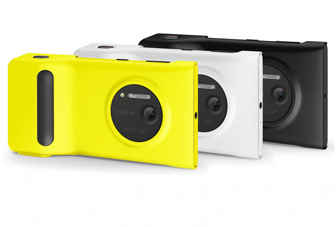
Hardware
The Lumia 1020 runs off a 1.5GHz dual core Qualcomm MSM8960 Snapdragon chip, the same that’s available in the Lumia 920 and Lumia 925, but what’s different with the insides of the Lumia 1020 is that it houses 2GB of RAM, most likely to process the large amounts of imaging data the 41 megapixel sensor pushes through its circuits.
The imaging duties are performed by a 1/1.5 inch sensor with an effective resolution of 38 megapixels. While conventional sensors are in the shape of a rectangle, Nokia uses a round sensor with a total resolution of 41 megapixels, but due to the rectangular nature of the images, 3 megapixels are lost. The reason for a circular sensor are to optimize the light coming in from the Carl Zeiss optics. The design helps ensure that the light all falls on the active imaging area and eliminates undesired effects like vignetting. The PureView 808 from Nokia that also boasted 41 megapixel worth of resolution had a slightly larger sensor (1/2 inches), but consequently, it also had a much larger bulge at the back. Nokia’s reduced the size of the sensor a little bit, kept the megapixel count the same, bringing the effective pixel pitch to 1.12 microns, something that most cellphone cameras can match. However, what’s unique about the Nokia sensor is that the software takes information from adjoining pixels to create one “super pixel” of sorts, and the sum total of this process yields a 5 megapixel image with impeccable quality and clarity.
Augmenting the 41 megapixel sensor is a 6 element Carl Zeiss lens, with optical image stabilization. OIS had originally been introduced in the Lumia 920, but gets refined for the Lumia 1020. Originally, the design used coils to move the entire lens assembly relative to the camera motion, to get a stable image. Nokia has now swapped out the coils for ball bearings, which seem to be more effective with more range of motions that the camera could be subject to. In case the low light situation is too daunting, Nokia’s also managed to pack in a Xenon flash tube to the back of the phone along with a small LED light that helps acquire focus and also is used as a video light.
If we are to look at the heart of the Lumia 1020, that is, the processor and GPU, they remain the same as those found in the Lumia 920 and Lumia 925. The RAM has doubled, the on-board storage is set to 32GB and cannot be increased because the phone lacks a microSD card slot.
Camera Performance
Nokia’s been hard selling the Lumia 1020 more as a camera than as a phone, and nobody can blame them. As a phone, it doesn’t bring anything revolutionary to the table, but as an imaging device, it’s quite a stunner. Who wouldn’t be impressed hearing about the fact that a camera phone has a 41 megapixel sensor? Well, to be honest, we were excited to see whether this sensor, which is smaller than the one in the PureView 808 can match the performance of its older, now defunct sibling.
Nokia Camera (Pro Cam Smart Cam)
Nokia’s taken their its with this phone and it shows. It’s not just about developing a sensor, but also about creating software that can leverage the full potential that resides in this sensor. Since Microsoft does not allow the in-OS apps to be altered in any way, Nokia created the Pro Cam app, that is capable to squeezing out the most from this camera’s sensor, but we’re here to wonder just how much there is to squeeze out of it.
We shot most of the photos for this review using the Pro Cam app, which is actually quite a marvel in of itself. It offers full manual control over every aspect of creating a photograph such as shutter speed, ISO, exposure compensation, white balance and even offers the ability to manually focus the lens. Of course there is no aperture control because the opening on the Lumia 1020’s lens is fixed at f/2.2, which is plenty for shooting in low light, but can be a little tricky to work with in bright daylight.
Now in our test, the very first experience with the Lumia 1020 ended up being an incredibly annoying one. When you press the dedicated shutter button on the right to kick the phone into camera mode, it takes a whole second to a second and a half before it is ready to shoot. This can be super annoying for anyone who’s looking to get off a few quick shots of a passing moment. As we woefully experienced, the slow startup time caused us to lose out on shooting some precious moments. However, there is a fix, but at a cost. If you don’t want to mess with the settings, you can set the stock camera app to open with the press of the shutter button, instead of Nokia’s Pro Cam. This opens much faster and can shoot much faster too, even between shots. Nokia Pro Cam takes another second and a half between shots as it saves a 5 megapixel version of the image you just shot along with a full resolution 38 megapixel image. This too can be changed, as you can choose to only save 5 megapixel images instead of both, saving not just space, but also shaving time between shots.
The app, as we said, gives full control over the photo taking experience. You can either tap on individual icons on top to open their respective setting, or just pull them all out by dragging the shutter button upwards (towards the earpiece). All the settings will now be on the screen and a thumb is all it takes to move them around. While the settings are pretty straightforward, it does take some getting used to the symbols. For example, the shutter speed icon’s symbol does little to convey what it is, until you actually pull it out and see the setting for yourself. Another little bit of the camera that you have to get used to.
As far as imaging goes, the camera app will give you the option to either save just the 5MP image or the 5MP plus the original 38MP image. If you choose to save just the 5 megapixel image, you won’t have any scope for recomposing later. However, you will still be able to use the lossless zoom feature to shoot your photos. If you also save the 38 megapixel images, you can creatively recompose your shots at any later time.
Studio Test
When gauging the image quality of the Lumia 1020’s camera, we looked at two sets of images, the studio shots and real world images. In our studio shot, the Lumia 1020 showed excellent center sharpness, which gradually reduced as we moved towards the edges, but not by a whole lot. The sensor was able to resolve up to 900 lines per millimeter, which is quite impressive for a camera phone. The colours are also quite good, as we saw a good degree of separation between our colour targets. Overall, the camera was able to resolve most of the detail in our test target to a level which was quite frankly beyond our expectation.
The main studio subject, and below, the crops.jpg)
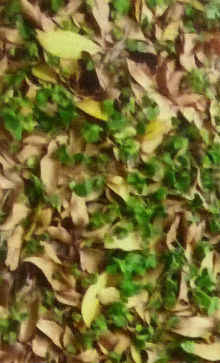
.jpg)
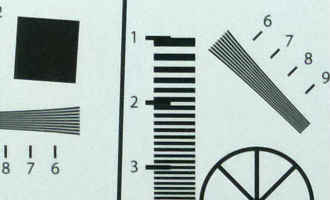
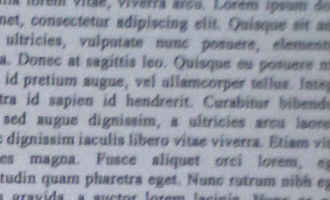
Click on above crops to enlarge in new window.
Real World Test
Real world situations, however, are seldom as controlled as a test target. In our test, we shot incredibly high contrast scenes, well lit scenes and even in low light. The Lumia 1020 got the same treatment we would dish out to a regular camera and the results are somewhat mixed. For starters, the slow camera can be painful, but when it IS ready to go, the images are actually quite good. We noticed that the images look slightly different on the phone screen than they do on our monitor and that is because the Lumia 1020 uses an AMOLED display, which by nature, boosts colours. Our monitor on the other hand is colour calibrated so the images look as they actually are. What we realized is that editing the photos on the phone could lead to more harm than good. We ended up with some images that had not enough saturation, or the contrast was too high etc.
Unedited images from the phone showed variable levels of contrast (very sensitive to shooting conditions), which is expected. What was not so expected was seeing just how good the dynamic range on the Lumia 1020’s camera is. When comparing it with other camera phones, it is quite a ways ahead, which isn’t surprising seeing how the sensor on the phone is also pretty large.
While the colours and contrast and dynamic range of the Lumia 1020’s camera are great, what really caught us by surprise was the fact that in real life conditions, the algorithms governing the image quality had a tendency to soften the image a little bit, causing some loss in detail. The other thing that’s a little annoying is that the Lumia 1020 prefers cooler tones, so the white balance is slightly blue-biased, but it’s not very noticeable. In fact, you can simply set your own white balance depending on the shooting situation and the colours will turn out fine.
Photos shot with the Lumia 1020 (click to enlarge in new window).
Conclusion
The Lumia 1020 is built on a hardware platform that has established itself to work rather well with the Windows Phone 8 operating system, as we have seen in the Lumia 920 and the Lumia 925. What is somewhat of a bomb feature about the phone is the PureView camera, which is sluggish despite the 2GB of RAM, but does take good photos. A major opportunity cost to this amazing little feature is that if you’re shooting in full resolution, you will use up your in-camera storage of 32GB rather quickly. The lack of a microSD card slot really hurts on this phone, as we were continuously forced to monitor the storage and offload files to our PC (deleting them from the phone) just so we could also have some music on here.
While the image quality of the Lumia 1020 is absolutely top notch, the camera app is painfully slow and there really isn’t much you can do about it. The Lumia 1020 is definitely not for the kind of photographer who loves to take split-second shots. Not just that, if you accidentally fire the shutter, you’re stuck another second and a half before the camera is ready to fire off again.
As a phone, the Lumia 1020 is easy to use and the camera bulge actually does not get in the way of the pocket’s contents (unless you’re wearing super skinny jeans or something). The call quality is good, though the speakerphone could have been a little louder.
Last but not the least, the battery on the Lumia 1020 is absolutely abysmal. The miniscule 2000mAh battery of the Lumia 920 is found in this phone too, but the imaging duties performed by the Lumia 1020 take a serious toll on this little slab of lithium. It could be assumed that Nokia didn’t improve upon the battery to ensure a slim form factor, but it could also be hypothesized that by not improving the battery capacity, the company is hoping to sell more camera grip attachments, which come with their own batteries.
Regardless, if you’re a stickler for image quality and want a good, slim, powerful camera in your pockets, then the Nokia Lumia 1020 should be your number one consideration, at least as far as phones go.
Swapnil Mathur
Swapnil was Digit's resident camera nerd, (un)official product photographer and the Reviews Editor. Swapnil has moved-on to newer challenges. For any communication related to his stories, please mail us using the email id given here. View Full Profile

.jpg)

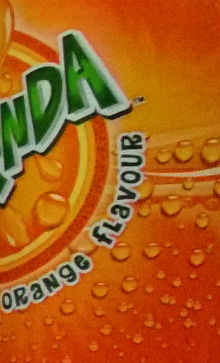



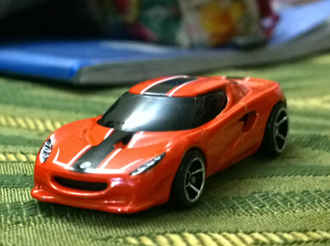










.jpg)

